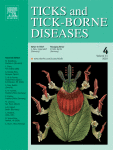Ver ítem
- xmlui.general.dspace_homeCentros Regionales y EEAsCentro Regional Santa FeEEA RafaelaArtículos científicosxmlui.ArtifactBrowser.ItemViewer.trail
- Inicio
- Centros Regionales y EEAs
- Centro Regional Santa Fe
- EEA Rafaela
- Artículos científicos
- Ver ítem
A Trypanosoma species detected in Rhipicephalus (Boophilus) microplus ticks from Argentina
Resumen
Specimens of a Trypanosoma sp. were found in a haemolymph sample of Rhipicephalus microplus from Argentina. Polymerase chain reaction (PCR) was done targeting the SSU rRNA gene of Trypanosoma spp. and a fragment of 2300 base pairs (bp) was amplified, subsequently a phylogenetic analysis was conducted, based on an alignment of 905 bp, containing the sequence of the Argentina isolate and sequences of different Trypanosoma species retrieved from GenBank.
[ver mas...]
Specimens of a Trypanosoma sp. were found in a haemolymph sample of Rhipicephalus microplus from Argentina. Polymerase chain reaction (PCR) was done targeting the SSU rRNA gene of Trypanosoma spp. and a fragment of 2300 base pairs (bp) was amplified, subsequently a phylogenetic analysis was conducted, based on an alignment of 905 bp, containing the sequence of the Argentina isolate and sequences of different Trypanosoma species retrieved from GenBank. Phylogenetic analysis revealed that this trypanosome is not related to Trypanosoma theileri as was previously thought, instead the strain of Trypanosoma detected in this study can be provisionally determined as belonging to the recently described organism Trypanosoma rhipicephalis. Furthermore, phylogenetic analysis performed in this work revealed that T. rhipicephalis belongs to a novel clade of tick-related trypanosomes, most with limited genetic data, for which essential aspects of both the vertebrate and invertebrate life cycles are lacking. The lack of basic information restricts the inferences that can be done from the present finding and, in addition, points out a clear knowledge gap in the biology of this group of trypanosomes.
[Cerrar]

Fuente
Ticks and Tick-borne Diseases 12 (1) : 101573 (January 2021)
Fecha
2020-09
Editorial
Elsevier
ISSN
1877-959X
Formato
pdf
Tipo de documento
artículo
Palabras Claves
Derechos de acceso
Restringido
 Excepto donde se diga explicitamente, este item se publica bajo la siguiente descripción: Creative Commons Attribution-NonCommercial-ShareAlike 2.5 Unported (CC BY-NC-SA 2.5)
Excepto donde se diga explicitamente, este item se publica bajo la siguiente descripción: Creative Commons Attribution-NonCommercial-ShareAlike 2.5 Unported (CC BY-NC-SA 2.5)

